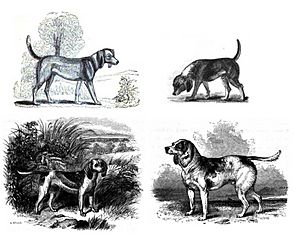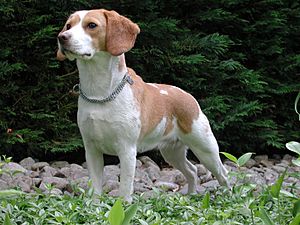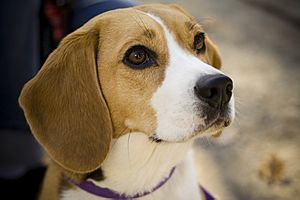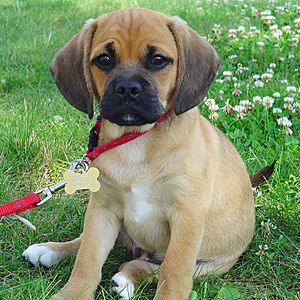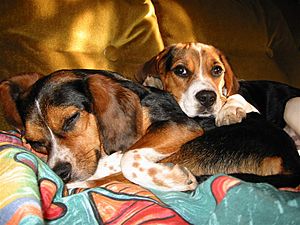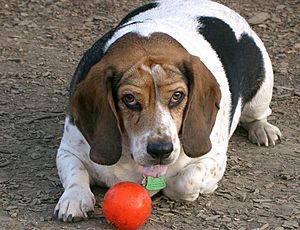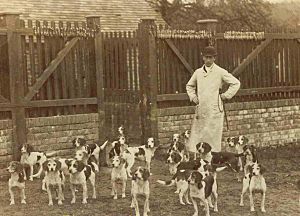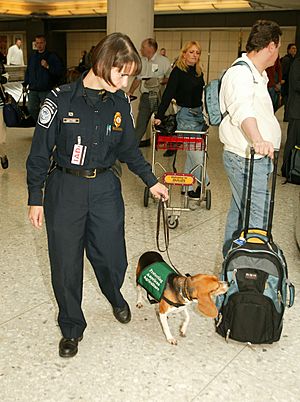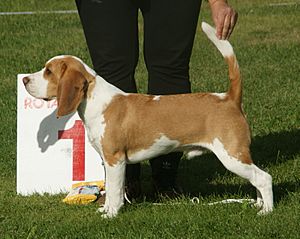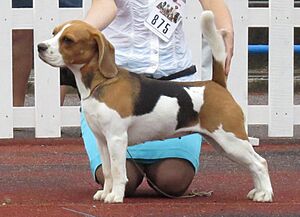Beagle facts for kids
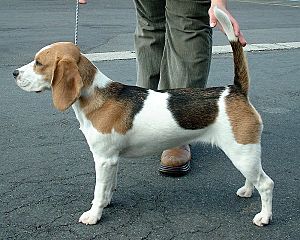
Tricolor Beagle
|
|||||||||||||||||||||||||||
| Other names | English Beagle | ||||||||||||||||||||||||||
|---|---|---|---|---|---|---|---|---|---|---|---|---|---|---|---|---|---|---|---|---|---|---|---|---|---|---|---|
| Origin | England | ||||||||||||||||||||||||||
|
|||||||||||||||||||||||||||
|
|||||||||||||||||||||||||||
| Domestic dog (Canis lupus familiaris) | |||||||||||||||||||||||||||
The Beagle is a type of small scent hound. It looks a bit like a larger foxhound, but it's smaller. Beagles were first bred to help hunters find hares. They have an amazing sense of smell and are great at tracking. Because of this, Beagles are often used as detection dogs. They help find forbidden food items and plants at airports around the world.
Beagles are also popular pets. People love them because of their size, friendly nature, and generally good health. The modern Beagle breed was developed in Great Britain in the 1830s. Several older dog types, like the Talbot Hound and the Southern Hound, helped create the Beagle we know today. Beagles have been famous in books, paintings, movies, and TV shows for a long time.
Contents
- History of the Beagle Breed
- Beagle Popularity
- What's in a Name?
- Beagle Appearance
- Amazing Sense of Smell
- Beagle Types and Crossbreeds
- Beagle Temperament
- Beagle Health
- Hunting with Beagles
- Beagles as Detection Dogs
- Beagles in Research
- Other Roles for Beagles
- Famous Beagles
- Beagles in Pop Culture
- See also
- Images for kids
History of the Beagle Breed
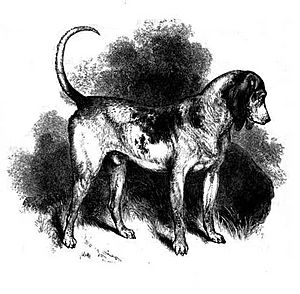
No one knows exactly where Beagles came from. Around the 11th century, William the Conqueror brought dogs like the St. Hubert Hound to Britain. These dogs were then mixed with Greyhounds to make them faster for hunting deer. Beagles are similar to the Harrier and the old Southern Hound, but they are smaller.
For a long time, "beagle" was a general name for smaller hunting dogs. These old "beagles" were different from today's breed. In the past, there were tiny Beagles called "Glove Beagles" or "Pocket Beagles." They were so small they could fit in a glove or a saddlebag! Queen Elizabeth I had Pocket Beagles. She called them her "singing beagles" because of their voices. Hunters would use larger dogs to chase prey. Then, they would release the tiny Beagles to follow the prey through thick bushes.
By the 1700s, two main types of dogs were used for hunting: the Southern Hound and the North Country Beagle. The Southern Hound was a large, slow dog with a great sense of smell. The North Country Beagle was smaller and faster, but not as good at smelling.
How the Modern Beagle Developed
In the 1830s, a man named Reverend Phillip Honeywood started a Beagle pack in England. Many believe his dogs were the start of the modern Beagle breed. His Beagles were small, about 10 inches (25 cm) tall, and pure white. Other important people, like Albert, Prince Consort, also had Beagle packs.
While Honeywood focused on hunting dogs, Thomas Johnson helped make Beagles both good hunters and good-looking. He developed two types: rough-coated and smooth-coated. The rough-coated Beagle is now extinct.
By the 1840s, Beagles started to look more alike. The differences between the North Country Beagle and Southern Hound faded. In 1856, a writer named "Stonehenge" described four types of Beagles. He said Beagles were like small, neat versions of the old Southern Hound.
By 1887, Beagles were no longer in danger of disappearing. The Beagle Club was formed in 1890. They created the first official standard for the breed. By 1902, there were 44 Beagle packs in England.
Beagles Around the World
Beagles arrived in the United States by the 1840s. At first, these dogs were mainly for hunting and varied in quality. In the 1870s, General Richard Rowett brought some good Beagles from England. His dogs helped create the first American Beagle standard in 1887. The American Kennel Club (AKC) officially recognized the Beagle in 1885. Since then, Beagles have become popular all over the world.
Beagle Popularity
Dog shows helped make Beagles look more uniform. The breed became very popular until World War I. After the war, Beagles struggled in the UK. The tiny Pocket Beagles likely disappeared during this time. But a few breeders helped bring interest back. By World War II, Beagles were doing well again.
Beagles have always been more popular in the United States and Canada than in England. The National Beagle Club of America started in 1888. In 1928, Beagles won many awards at the Westminster Kennel Club show. In 2008, a Beagle named Uno won the "Best In Show" title at Westminster for the first time ever! Another Beagle, Miss P, won in 2015.
For over 30 years, Beagles have been one of the top ten most popular breeds in North America. From 1953 to 1959, the Beagle was the number one registered breed with the American Kennel Club. In 2012 and 2013, they were the 4th most popular breed.
What's in a Name?
The word "beagle" first appeared in English writings around 1475. No one is sure where the name "beagle" comes from. Some think it comes from the French word "begueule," which means "gate throat."
There's also a dog called the Kerry Beagle from Ireland. It's much taller than today's Beagle. Some people think the modern Beagle's great sense of smell might have come from mixing with the Kerry Beagle long ago.
Beagle Appearance
A Beagle looks like a smaller version of a Foxhound. But its head is wider, and its nose area is shorter. Beagles usually stand between 13 and 16 inches (33 and 41 cm) tall. They weigh between 18 and 35 lb (8.2 and 15.9 kg). Female Beagles are usually a bit smaller than males.
They have a smooth, slightly rounded skull. Their muzzle is medium-length and square. Their nose is black, or sometimes liver-colored. Beagles have strong jaws and teeth that fit together like scissors. Their eyes are large and brown or hazel. They often have a gentle, pleading look. Their large ears are long, soft, and set low on their head. They turn slightly towards their cheeks and have rounded tips.
Beagles have a strong, medium-length neck. This helps them easily bend down to sniff the ground. They have a broad chest that narrows towards their waist. Their tail, called the "stern," is long and slightly curved. It has a white tip, which helps hunters see the dog when its head is down. The tail stands upright when the Beagle is active. Beagles have a muscular body and a smooth, medium-length coat. Their front legs are straight, and their back legs are strong and bent at the knees.
The most common Beagle color is tricolored. This means they are white with large black areas and light brown shading. Tricolored Beagles come in different shades. Some have a very black "saddle" on their back. Others have more brown mixed with the black. Tricolor Beagles are almost always born black and white. The white areas are usually set by eight weeks old. But the black areas might fade to brown as the puppy grows. This brown color can take one to two years to fully appear. Some Beagles even change color throughout their lives.
Two-color Beagles always have a white base with another color. Tan and white is the most common two-color type. Other colors include lemon (a very light tan), red (a reddish-orange brown), and liver (a darker brown). Liver is rare and not allowed in some breed standards. Some Beagles also have small spots or flecks of color, called "ticking." For example, a blue-mottled Beagle has spots that look like a dark blue.
Amazing Sense of Smell
Along with the Bloodhound and Basset Hound, the Beagle has one of the best senses of smell of any dog breed. In the 1950s, scientists studied how well different dogs could smell. They put a mouse in a large field. Beagles found the mouse in less than a minute! Other dogs took much longer or couldn't find it at all. The Beagle's long ears and large lips probably help trap scents close to their nose.
Beagle Types and Crossbreeds
Beagle Varieties
The American Kennel Club recognizes two sizes of Beagles. One is for dogs less than 13 inches (33 cm) tall. The other is for dogs between 13 and 15 inches (33 and 38 cm) tall. The Kennel Club (UK) recognizes one type, between 13 and 16 inches (33 and 41 cm) tall.
Sometimes you hear about "English" and "American" Beagles. But no official Kennel Club recognizes this difference. American Kennel Club Beagles are generally smaller than UK Kennel Club Beagles.
"Pocket Beagles" are sometimes advertised for sale. However, this tiny variety is no longer officially recognized by any Kennel Club.
Beagle Crossbreeds
Recently, "designer dogs" have become popular. One well-known cross is the Beagle and Pug mix, called a puggle. Some Puggles are calmer than Beagles and need less exercise. But many are very energetic and need a lot of play time.
Beagle Temperament
Beagles are known for being even-tempered and gentle. Many breed standards describe them as "merry." They are usually friendly and not aggressive or shy. They love company and can easily make friends with strangers. This means they don't make good guard dogs. However, they do bark or howl at new things, which makes them good watch dogs.
Beagles are great with children. This is a big reason why they are popular family pets. Beagles are "pack animals," meaning they like to be with others. They can get separation anxiety if left alone too much. This might cause them to chew on things. Not all Beagles howl, but most will bark at strange things. Some will also "bay" (make a long, deep sound) when they smell something interesting. They usually get along well with cats and other dogs.
Beagles don't need endless exercise. They have a lot of energy, but they also like to rest. Regular exercise helps them stay healthy and avoid gaining too much weight.
Beagle Health
Beagles usually live for 12 to 15 years. This is a normal lifespan for dogs their size.
Beagles can sometimes have epilepsy, but medicine can often control it. They can also have hypothyroidism (a thyroid problem) and some types of dwarfism. Two rare conditions are unique to Beagles. One is "Funny Puppy," where puppies develop slowly and have weak legs. The other is Musladin-Lueke syndrome (MLS), which affects their eyes and toes. Hip dysplasia, a joint problem, is rare in Beagles. Beagles are prone to certain disk problems in their spine.
In rare cases, Beagles can get a joint problem called immune mediated polygenic arthritis. This can happen even when they are young. Their long, floppy ears can trap moisture, leading to ear infections. Beagles can also have eye problems like glaucoma and corneal dystrophy. "Cherry eye" and distichiasis (eyelashes growing into the eye) can also occur. These can often be fixed with surgery.
Since Beagles love to explore, they can get minor injuries like cuts. If they don't get enough exercise, they can easily become overweight. They love to eat! When outside, they might pick up fleas, ticks, or tapeworms. Grass seeds can also get stuck in their eyes, ears, or paws.
Beagles sometimes do something called "reverse sneezing." They sound like they are choking, but they are actually just breathing air in quickly. This is usually harmless.
A rare condition called "Beagle pain syndrome" can affect Beagles. It causes fever and neck pain.
Reproduction
A mother Beagle usually has about six puppies in a litter. Newborn Beagle puppies are very tiny, weighing only a few ounces each.
Hunting with Beagles
Beagles were originally bred for hunting hares, an activity called "beagling." They were perfect for hunters who couldn't ride fast horses all day. Beagles are not super fast, but their amazing sense of smell and stamina meant they would almost always find the hare. Beagle packs would hunt very closely together. This helped them stay on the trail during long hunts.
In the United States, Beagles were mainly used for hunting rabbits. Hunting with Beagles became popular again in Britain in the mid-1800s. This continued until it became illegal in Scotland in 2002 and in England and Wales in 2004. Now, Beagles can still chase rabbits with the landowner's permission. Some people enjoy "Drag hunting," where dogs follow a scent trail instead of a live animal. This lets Beagles use their natural hunting skills.
Many British schools used to have Beagle packs for students to learn hunting. Today, some schools like Eton and Marlborough still have them. Besides organized hunting, Beagles are also used to flush out other animals for hunters, like snowshoe hares, cottontail rabbits, and even foxes.
Beagles as Detection Dogs
Beagles are used as detection dogs by the United States Department of Agriculture. They are part of the "Beagle Brigade." These dogs sniff out food items in luggage at airports. Beagles were chosen because they are small and friendly, so people aren't scared of them. They are also smart and work well for rewards. Other countries like New Zealand, Australia, Canada, and Japan also use Beagles for this job. Larger dogs are usually used for finding explosives because that job often involves climbing.
Beagles in Research
Beagles are often used in animal testing because of their size and calm nature. In the United States, many Beagles are used each year for medical and other tests. These dogs are bred specifically for this purpose and live in cages. Organizations like the Rescue + Freedom Project work to free Beagles from labs.
In the UK, Beagles are involved in a high percentage of dog testing. Most of these dogs are bred by special companies for research. Some places have banned testing cosmetic products on animals. In the US, it's allowed but not always required if other safety methods exist. Minnesota was the first state to pass a "Beagle Freedom" law in 2014. This law allows dogs and cats to be adopted after they finish research testing.
Other Roles for Beagles
Even though they were bred for hunting, Beagles are very versatile. Today, they have many other jobs. They work in detection, help people in therapy, and are wonderful family pets.
In Australia, Beagles are used to sniff out termites. They have also been considered for finding drugs and explosives. Because they are gentle, Beagles are often used in pet therapy. They visit sick and elderly people in hospitals. In 2006, a trained Beagle assistance dog even saved its owner's life by dialing an emergency number on a cell phone! After the 2010 Haiti earthquake, a Beagle search and rescue dog helped find a person buried in the rubble. Beagles have even been hired in New York City to help find bedbugs.
Famous Beagles
- Uno: The first Beagle to win the Westminster Kennel Club Dog Show in 2008.
- Miss P: Won the Westminster Kennel Club Dog Show in 2015.
Beagles in Pop Culture
- Famous cartoon Beagles include Snoopy from Peanuts, who is called "the world's most famous Beagle." Gromit from Wallace and Gromit is also a Beagle.
- Former US President Lyndon Baines Johnson had several Beagles.
- The ship HMS Beagle was named after the dog breed. Charles Darwin sailed on this ship, and his journey helped him develop his ideas about evolution. Later, a Martian lander was named Beagle 2 after the ship.
- A Beagle named Brian is a character in the Inspector Gadget films.
See also
 In Spanish: Beagle para niños
In Spanish: Beagle para niños
Images for kids


